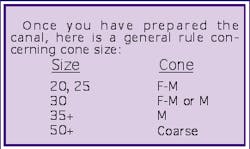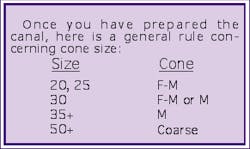HOW TO PROFIT FROM...endodonticsAn endodontic "genie" to boost profitabilty
by Ken Koch, DDS and Dennis Brave, DDS
Most genies grant three wishes (union rule!) The most common endodontic wishes are:to make root canal therapy easier, faster, and better. The outcome of these three wishes is increased profitability. The road to endodontic profitability is truly paved by the .06 preparation. If you can understand the rationale of the .06 preparation, and can learn to perform it in a consistent manner, you will be stunned by how quickly endodontics can become a profit center in your practice.
Two of the major benefits of the .06-tapered preparation are:
- A dramatic reduction in post-operative sensitivity
- The ability to perform more cases in one visit.
This combination will lead to increased patient satisfaction and will be a practice builder.
By performing a .06 preparation, the larger taper removes the tooth structure in the coronal part of the canal, an area that has a tendency to bind instruments. This constricture is very evident when using hand files. The removal of this tooth structure results in a dramatic increase in proprioceptive ability — in other words, more tactile awareness.
In addition to this increased sense of awareness, the .06 preparation allows our irrigation agent (bleach) to work in a more efficient manner. Remember the endodontic truth: "Instruments shape, irrigants clean." How effective is your irrigation agent when you can hardly screw a No. 25 hand file to length? Not very effective! But with an .06 preparation, the irrigation agent gets into the root canal system right from the start.
We must think of the root canal as a three-dimensional system, with webs, fins, and anastomoses. The only way to effectively clean these areas is through the use of our irrigation agent. The irrigation agent works much more effectively in a tapered .06 preparation as compared to a .02 or .04 preparation. Additionally, the .06 preparation lets the clinician use an ultrasonic to generate acoustic streaming and achieve the cleanest possible canal.
Another benefit of the .06 preparation is the reduction in extruded debris. When performing a root canal with hand files, too often we push debris out past the end of the tooth. We are, in a sense, inoculating the periapical tissues. The result is increased post-operative sensitivity, if not severe pain and swelling.
Using tapered rotary files in conjunction with an .06 preparation pulls debris coronally rather than pushing it in an apical direction, and significantly reduces post-operative sensitivity.
The value-added benefit of this technique comes after we have created a fully tapered .06 preparation. This is the primary cone fit. Instead of guesstimating and becoming frustrated with bent cones, the .06 preparation makes the primary cone fit a no-brainer. Here's the technique.
A good rule is to develop an obturation technique that matches your instrumentation technique. The most significant impact of rotary instrumentation on endodontics is providing dentists with the ability to create consistent, predictable shapes. Performing a .06 preparation requires only one of two sizes of gutta percha points 98 percent of the time — either fine-medium or medium cones. These are nonstandardized cones. Let's take a closer look at gutta-percha cones.
We have standardized and nonstandardized cones. Standardized cones are the cones most dentists have in their cabinets. For example, 20, 25, 30, 35, etc. are ISO-sized in apical diameter, as well as ISO-sized in taper (.02). Nonstandardized cones come in sizes fine-fine, medium-fine, fine, fine-medium, medium, and coarse. As previously mentioned, the sizes you will employ 98 percent of the time are fine-medium (F-M) and medium (M). Nonstandardized cones have a more pronounced taper and can be fit to either an .04 or .06 tapered preparation. As an alternative, you can use a tapered cone such as a .06 (SybronEndo).
There are other cones available from Charles Schwed and DiaDent that are ISO-sized, (25,30, etc.) that come in different tapers such as .04 and .06. Also, some manufacturers have cones that match specific file tapers such as the Autofit cones by Analytic Endodontics and the GTs by Dentsply Tulsa Dental.
What is most important is to know how to properly fit or size a nonstandardized cone. Here is an easy way : Let's say, for example, the last instrument was a size 25. You take the F-M cone and place it into the canal, going a bit past the apical constriction. This is not a problem because it is only a gutta-percha cone.
Instead of guessing at the apex, like we often do with standardized cones, we advance the cone until it is snug at the apex. An example would be if you make a small circle with your left thumb and forefinger and then place your right forefinger through the circle until it binds. Of course, at this point your cone fit will be slightly overextended, but not underfilled at the constriction.
The great part of this technique is that when we remove the cone and examine it, the section of the cone that is over-extended is generally bent and crinkled. All we now do is trim the cone at the level of the crinkles. This corresponds to the level of the apical constriction. Of course, you can verify the adjusted cone with an X-ray to confirm that it matches the final working length. We can't make it any more simple! This is a sweet way to achieve a good cone fit.
The frequent criticism, "How do we know where the cone is binding?" does not apply here because we have created a fully tapered, .06 preparation, not a .02 parallel shape as with hand files. We can confidently state that whatever obturation method you use — lateral condensation, vertical condensation, System B, etc. — all work better with a .06 preparation. Even the solid-core obturator systems such as Thermafil work better with a .06 preparation because you do not have to "verify" the size. This is related to the taper of the plastic carrier. If you finish with a No. 25 .06 taper, you simply fill with a No. 25 Thermafil.
When we do live demonstrations at our Real World Endo courses, the participants are always stunned at the ease of the cone fit. It is all a result of the .06 preparation. The rotary files that we prefer to use when performing a fully tapered, .06 preparation are the Series 29 .06 Profile (Dentsply Tulsa Dental) and the new .06 taper K3 file by SybronEndo. These are both excellent files and we recommend that you try both of these files on extracted teeth or blocks before using them on patients.
There is even more good news concerning this "endodontic genie." Because it is faster and more effective, the .06 preparation allows you to perform more single-visit endodontics. This is not only very profitable, it is a huge practice builder. The timesavings, of course, translate into greater production and net profit. We also want to stress that there is a tremendous savings in consumables, such as patient set-up supplies (napkins, anesthetic solution, suction tips, etc.).
The continuously tapered .06 preparation will increase your ability to ideally prepare most root canals and to create a preparation that is well-suited for all obturation techniques.
Will this Genie ever go back into its bottle? That's hard to say. But what we can say is this — it is clear, as our motto states, that with "Just the Facts, Nothing But the Facts," you will be able to make endodontics a profit center for your practice.
Drs. Brave and Koch together are Real World Endo, an endodontic education company. They can be reached at (866) RWE-ENDO, or visit their Web site at www.realworlden do.com.

